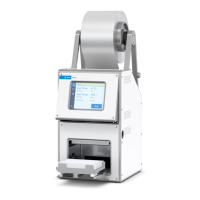11
PlateLoc Thermal Microplate Sealer
Frequently asked questions
Reference for Optimal Thermal Microplate Sealing
A
We suggest waiting a minimum of 10 seconds or as long as it takes for the
sealing film on the microplate to return to room temperature.
Removing seal from cold storage microplates
Q
We’d like to seal our pharmaceutical microplate library, and store the sealed
microplates at –20 °C. Do we need to allow the microplates to return to room
temperature prior to peeling off the seal?
A
Yes. Sealed microplates that have been stored in a refrigerator or freezer
should be returned to room temperature before attempting to remove the seal.
It is good laboratory practice to thoroughly test your methods prior to sealing
an entire compound library. Be sure to choose a seal material that is designed
for low- temperature storage and is removable (peelable). Note that some seals
are designed to not be peeled off, but rather pierced mechanically for sample
access.
Minimizing or eliminating cross-contamination
Q
How careful do we need to be when we manually peel off the seal by hand?
What if there is liquid under the seal? Can droplets from one well contaminate
another?
A
There is always the chance that condensate or liquid from a sample well may
be transferred to the underside of the sealing film. One option is to centrifuge
the microplate before removing the seal. Another option is to not remove the
seal—use a pierceable seal. Whether you choose peelable or pierceable seal, it’s
best to centrifuge the microplate before removing samples.
Gas-purging option
Q
The samples we have are in DMSO and we plan to use the PlateLoc Sealer to
seal our microplates with Agilent Technologies Peelable Aluminium Seal PN
06643.001 prior to putting our microplates into storage at –20 °C. How might
we further reduce hydration and oxidation while sealing these microplates?
A
The Agilent Technologies gas- purging PlateLoc Sealer was developed for
pharmaceutical customers to replace the air (containing moisture and oxygen)
in their microplate wells with a dry, inert gas such as argon before the
microplates are sealed. Because of the permeability of microplate materials
such as polypropylene and polystyrene, the gas- purging effects typically last up
to 24 hours when the microplates are stored at room temperature, perhaps
longer if stored at lower temperatures.

